THIS IS THE U.K. HISTORIC ARMS RESOURCE CENTRE ............. FREE OF COOKIES, TRACKING & ADVERTISEMENTS
Please be aware that some specialist rotational imagery on these pages may take longer than usual to load
The Parker-Hale "TARGETSCOPE"

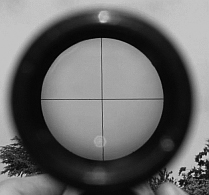 ................
................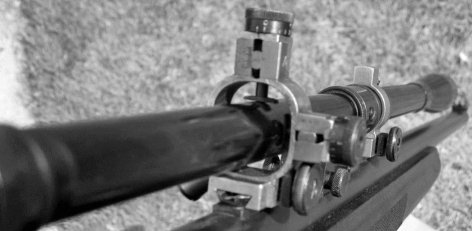
The 1939 advertisements
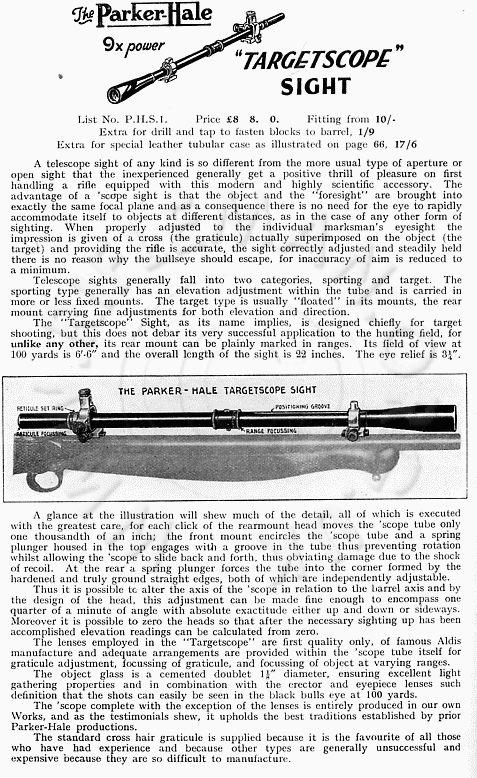
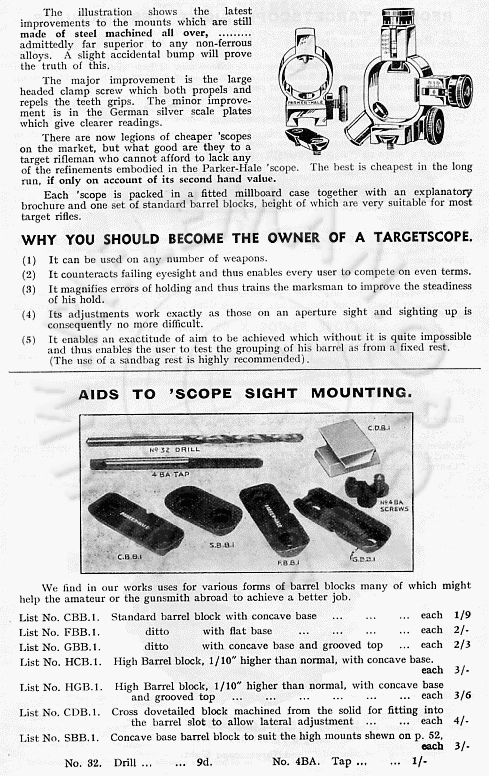
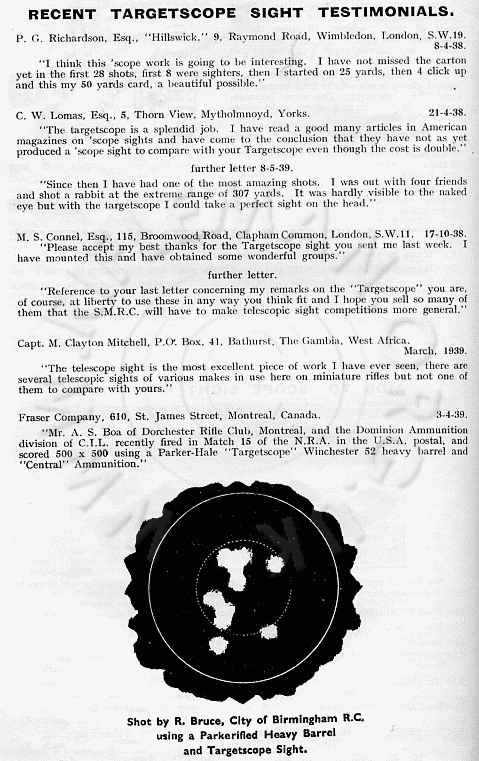
Perhaps not an entirely correct assessment of how
things were to turn out sixty years on, but, nevertheless, a perfectly reasonable
outlook for the telescopic sight in small-bore target shooting was made by A.G.
Banks ( winner of the first "Queen's
Cup" competition in 1907 with a Greener Martini rifle) in his book
"Random Notes on Rifle Shooting". He stated in 1932 that:
"Personally, I have little doubt that in a few years'
time telescopic sights will have taken the place of aperture sights on TARGET RIFLES
as a standard fitting, and everyone will wonder why on earth we did not
adopt them years ago.The lead will come from the older shots - for to the man
with failing eyesight the 'scope sight is the greatest boon ever invented."
Banks went on to detail the prime telescopic sight
on offer in 1938 - the Parker-Hale Targetscope and
illustrated a rather " Heath Robinson", but nonetheless inventive,
way of mounting the 'scope to a Greener Martini actioned target rifle
and utilising a Parker-Hale No.7 or BSA No.30 type rear aperture sight to permit accurate
and easy adjustment for windage and elevation.
"A BALL-JOINT 'SCOPE-SIGHT ATTACHMENT"
"I DO not suppose anyone will deny—anyone in Britain, at any rate—that
Messrs. Parker-Hale's "Targetscope" and mounts constitute the best
telescopic sight outfit available at any price. In fairness to the vast amount
of work which that firm have put into the design of this outfit, it is incumbent
upon me to keep that fact clearly before my readers, and I have done the "Targetscope" full justice in previous articles. Unfortunately, however,
many of us are unable to afford the money necessary to secure one of these high or super-class sets, and people
who are searching for something cheaper but still capable of giving the highest
class results, not obtainable with the cheapest American sets, may be interested
to hear of my latest development."
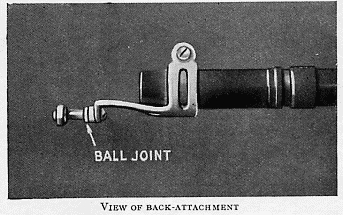
"VIEW OF BACK-ATTACHMENT"
Much of the cost of a " TARGETSCOPE " of course goes into the back
mount, which is accurately and solidly made to give quarter-minute click adjustments.
But every modem target rifle is already equipped with an equally well-made aperture
back-sight giving the same thing ;'and if you can harness the back of your 'scope
to this aperture sight and make it do the clicking for you, the necessity for
a special back mount is obviated. This I have done, and I now proceed to give
you a description of the method.
Several years ago (" How to Make a Telescopic ) Sight for
Ninepence ") I described one such arrangement, but my present set consists
of a back attachment to the aperture sight and a front block attached to the
rifle barrel by a bolted clip, which can be used with the S.M.R.C. 'scope and
fitted in a few minutes by anybody to any standard B.S.A., Vickers, or Greener
M.52 without any alteration, drilling, or screwing, etc., whatever. In the case
of the S.M.R.C.-Parker-Hale C.M.T.2, it is only necessary to hollow out or cut I away a little of the forend to clear
the front clip.My set is designed more especially for the S.M.R.C. 'scope because,
at three pounds ( £3.00) I know or no other 'scope to equal it. I see
that its magnification is advertised as 8 x, but that is a mistake. It is actually
much better, being nearer 11 x, and all its optical arrangements are excellent.
My attachments can, however, be adapted to any 'scope of similar build, that
is, of the long, thin type, like the " TARGETS
cope " and the"
S.M.R.C." For the front, you want an ordinary front mount (through which
the 'scope tube slides) which slides on to the barrel-block and is secured by
a finger screw. These are cheap enough, but it is essential that the rib of
the 'scope is a dead fit in the slot of the mount, for the 'scope must not be
able to twist round at all, and the front mount must be responsible for preventing
this. As regards the rear fixing, you can not do with a rigid attachment to
the backsight because, although the movements of the eye-cup block for line
and elevation are small, a rigid attachment would cause the 'scope-tube to strain, and bring strain to bear on the back- sight. This would in time result in looseness
and get you into hot water with the makers when you sent the sight back and
blamed them , for it!
It was the problem of designing an attachment which, while giving sure movement
to the 'scope from the clicks, would allow this necessary flexibility, which,
gave me sleepless nights. However, the solution is simple, and consists in effect
of a ball-joint. You take out your eyecup, which screws into a hole about 1/4-inch
diameter in the eye-cup block. Through this hole now goes a horizontal bolt
fixed to the back of the attachment, and much smaller in diameter than the hole
(5/32 in.). At the head of the bolt is a small spherical-faced washer, slightly
larger than the hole. The bolt is secured at the back of the sight-block by
a spring washer and nut, finger-tight. Thus the ball-face bears on the metal
of the block at the edge of the hole, and forms a ball-joint, while the spring
washer allows the bolt to move around a little in the hole as the adjustments
are made. The illustrations herewith will make clear the general arrangement,
and, incidentally, reveal to any old cyclists among you that the materials I
used were, a certain old-fashioned type of cycle lamp-bracket and a couple of
small cycle-bolts! You also require, of course, a certain skill in the art of
using a file, if you are going to make your own ball-washer! I anticipated criticisms
to the effect that this was a wobbly sort of arrangement and that it would not
stay put. In fact, I admit to some misgivings on the point myself, before I
tried it. The proof of the pudding is in the eating ; and the actual facts are
that the 'scope is held with amazing rigidity and that it stands up to continuous
shooting and answers the helm perfectly. As no rifleman in his senses is going
to make a practice of knocking any 'scope sight about or even risk leaning his
rifle on it, the strength afforded is ample for all requirements. Also, you
can take the 'scope off the gun and replace it with the certainty of its keeping
the same zero.
As you know, I like to anticipate criticism as much as possible
and to provide proofs of my statements. It saves such a lot of unnecessary correspondence
afterwards! So in order to prove that the sight goes back without alteration,
after being removed, I am publishing a 25-yards target. It looks a very ordinary
target, worth 98 (or 99 if Mr. Tucknott is feeling generous!), with the elevation
set a bit too high. But it is, in fact, a very extra ordinary target ; because
the 'scope was removed completely from the rifle and. refixed after each bull— five times,
and, incidentally, dropped once! I can assure you that doing this on the firing
point, in the prone position, and getting in and out of the sling, is shooting
under difficulties and is hard work, so I must be excused for not producing
a '' possible " ; for I found one such target quite enough.
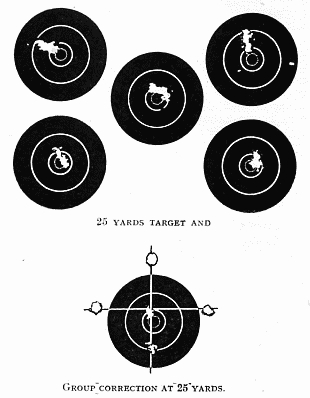
The " Sighter Bull " of this card was shot last, as proof of another
point—that the ball-joint does really communicate the click adjustments
accurately and consistently. The five shots, all aimed at the centre, were fired
respectively with 8 clicks up, 8 clicks down, 8 clicks right, 8 clicks .left,
and then back to zero for the last shot. This bull I have cut out and illustrated
separately to show up the shots. It also shows that I had the elevation set
too high. It should have been one click lower. It must be understood that the
clicks now give more than quarter-minutes, owing to the shorter sight radius
between the mounts than between backsight and ordinary foresight Actually four
clicks give you 1-1/2 ins. at 100 yards, 3/4 in. at 50 and 3/8 in. at 25. In
other words, each click gives exactly half as much again on the target as it
does when used in the ordinary way with a foresight. This looks at first glance
rather a bore, but in practice I am not sure that it is not an actual advantage.
One finds so often in shooting a situation where one feels that one click will
not be enough, while two may be too much. Here you get an allowance exactly
half- way between, with one click! After these preliminary 25 yards' tests I
then had to prove that the outfit would " do its stuff " on the 100
yards range, and stand up to continuous shooting. At last the requisite calm
day came along, and I sallied forth. The usual elevation with this rifle from
25 to 100 yards -was 8 minutes. I therefore calculated that 5-1/2 "degrees"
on the sight should about do the trick, and it did. The first shot was a bull
with elevation practically correct. The first ten shots made a 1-1/8 in. group.
I fired three more 10-shot groups, and they measured respectively 2 ins., 1
in. and 1-3/8 ins., the last being centred all in the bull. I came away perfectly
satisfied that the 'scope fixings were as solid as a rock and would go on doing
it indefinitely. This S.M.R.C. 'scope spots in the black at 100 yards quite
easily, if you have the usual white backing sheet behind ; and I never took
my spotting telescope out of the case. That is pretty good illumination, you
know, for an 11-power 'scope. The only trouble is, you have to resist the fatal
fascination of wanting to move your cross hairs away to watch the shot go through
the bull! If you do, it doesn't. By means of the attachments described, the
'scope is held , in the lowest position which would be feasible, while still
allowing space convenient for loading the rifle—that is, about half an
inch higher than the normal iron-sight line. One looks over the top of the backsight,
of course, and the full field of the 'scope is visible with the exception of
a small segment of the left side, which is unavoidably blocked out by the elevation
screwhead. Even this can be avoided if one takes the trouble to set the 'scope
to zero with the wind gauge set well over to the right; but it is of no practical
importance, and I prefer to have my 'scope set to zero, by means of the front mount, with the wind-gauge also at
zero—i.e., in the centre of its travel. (April, 1938.)
So much of "A.G's." comment is still valid
today, as are his following remarks on the subject of shooting with a telescopic sight.
"The first thing one finds, upon using a 'scope sight, is that, whereas
one used to think that one could hold " rock steady," the rifle now
appears to dither about as though possessed, even when using the relaxed hold.
It is a matter almost of impossibility to hold the cross hairs steady on the
centre of the bull for X more than a moment, and so one realises why in the
past so many shots which one thought would be central bulls actually turned
out to be clipping bulls or even nines. The danger in 'scope sight shooting
is of concentrating so much upon the aim that the niceties of hold and trigger
release, which I have dealt with in recent articles, are neglected. It is very
fascinating to watch the shot hit the target, when it appears in the spot where
one is looking for it. When it does not, it is not so fascinating!
Using a telescopic sight, there is no doubt whatever when the aim is perfect,
and it drives home to one the fact that real shooting depends chiefly upon regular
holding ; for when a perfectly aimed shot falls elsewhere than in the centre,
given first-class tools, there is no question at all that the holding or trigger
release is at fault. Nothing could popularise the genuine telescopic sight more
than the general trial of this experiment which I have carried out and described,
and when a real demand arises, manufacture in large quantities will ensure a
much reduced price. "
"A.G." did not mention that the use of
a telescope for practice can provide the very best indication of one's faults
with hold, breathing, aiming and let-off. Suddenly all the errors, previously
unseen and unknown whilst shooting over or through iron sights, are magnified,
visible and, most importantly, correctable.
We now copy the very comprehensive Parker-Hale brochure
for their 'scope. It is best shown in pictorial format and will surely have
loaded on broadband by the time you read down to here!
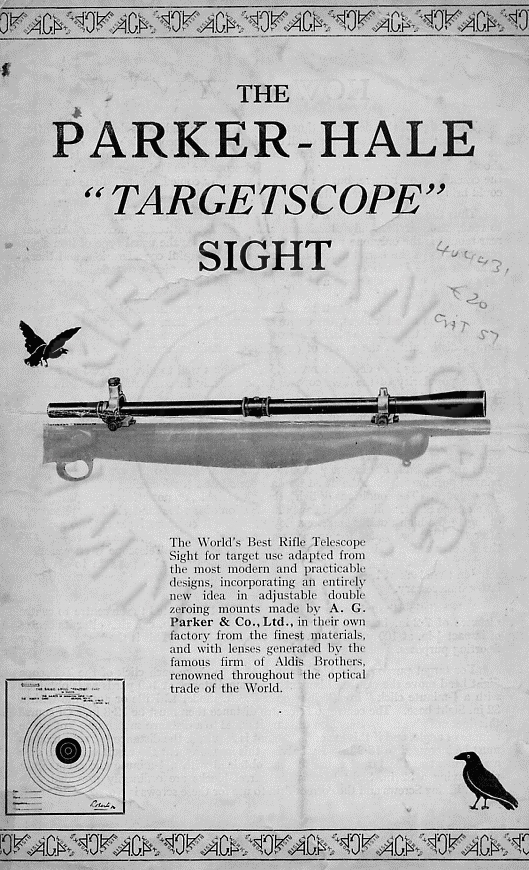
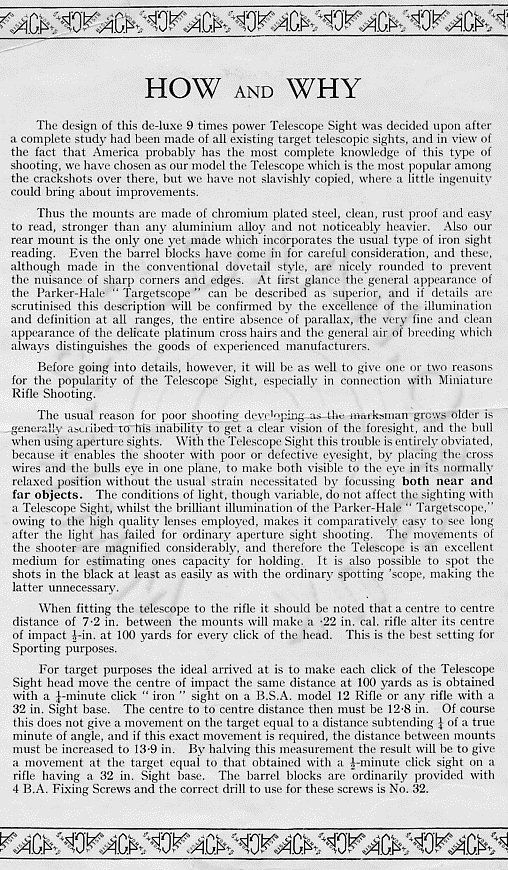
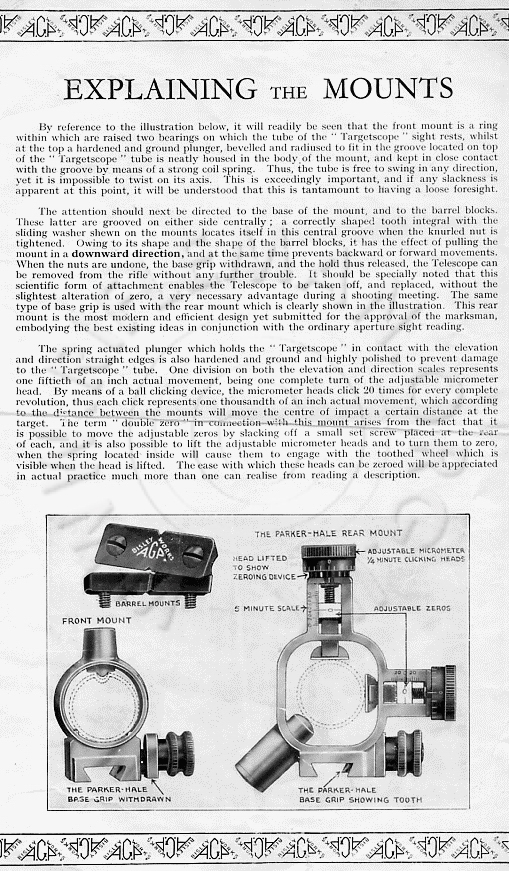
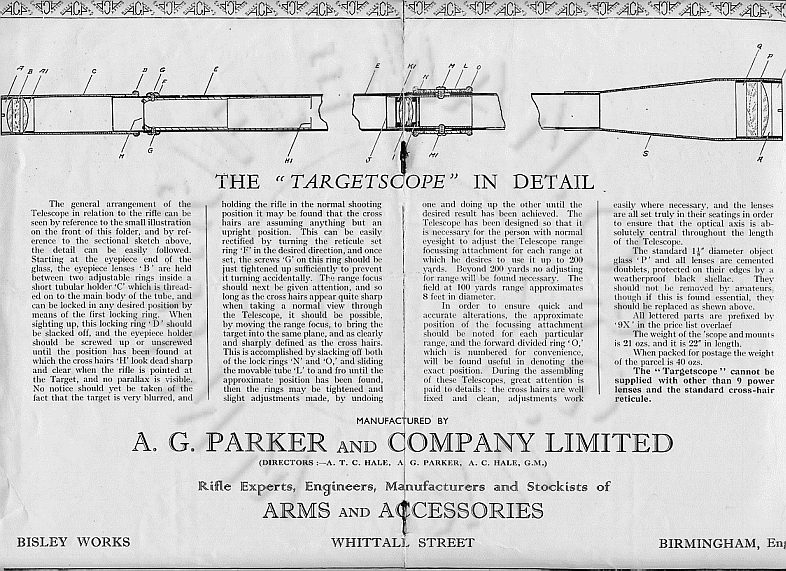
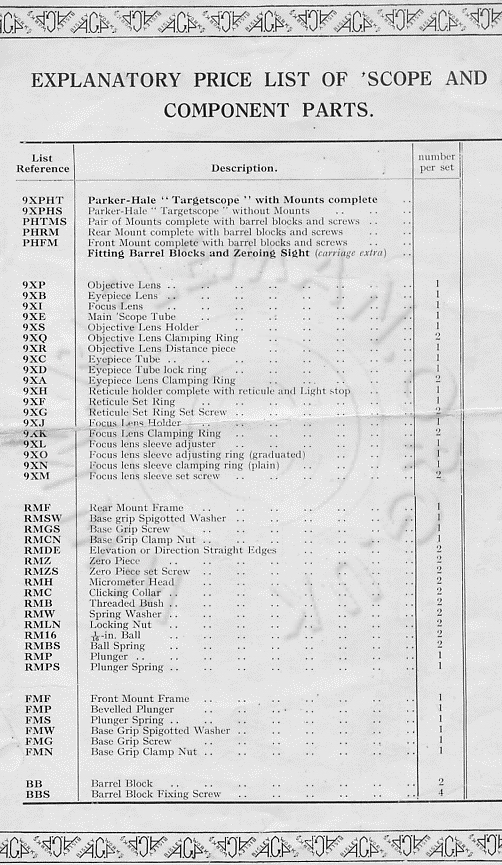
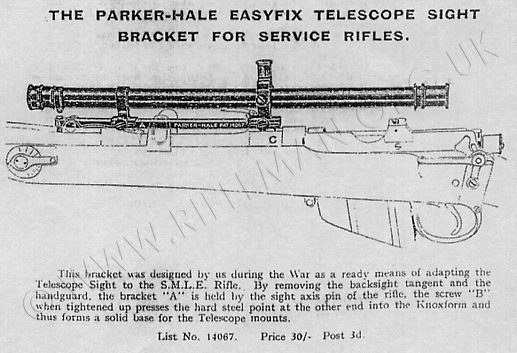
Parker-Hale's 1940 advertisement for a 'scope mount suitable
for the S.M.L.E rifle
To close, in order not to offend or mislead any North American readers, we should mention that we are aware that these scopes were manufactured by J.W. Fecker of Cleveland and imported by Parker-Hale for sale in Great Britain under their own name. A considerable recommendation we would have thought.
The Fecker front mount has their name and place of manufacture cast into it.
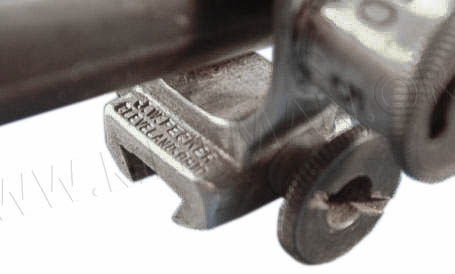
A contemporary advertising leaflet is shown below.
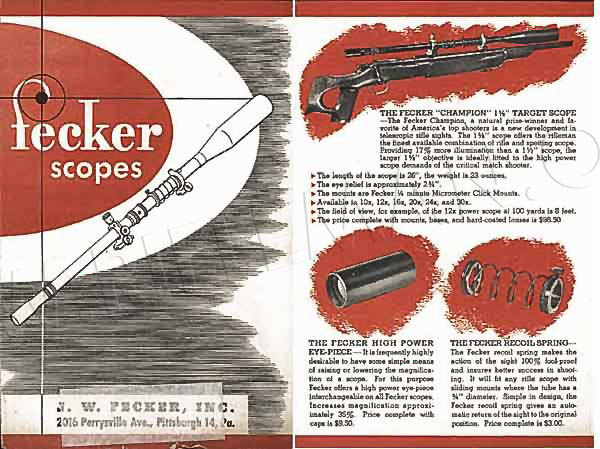

See also the Parker-Hale
CMT rifles , the Parker-Hale_Dewar_rifles and ParkerRifling, A.G._and_A.J.
,
plus Parker-Hale
Service Rifle Target Sights, and the Parker-Hale Optical Sight Set
Return to: TOP of PAGE
See this website's Raison d'être


















